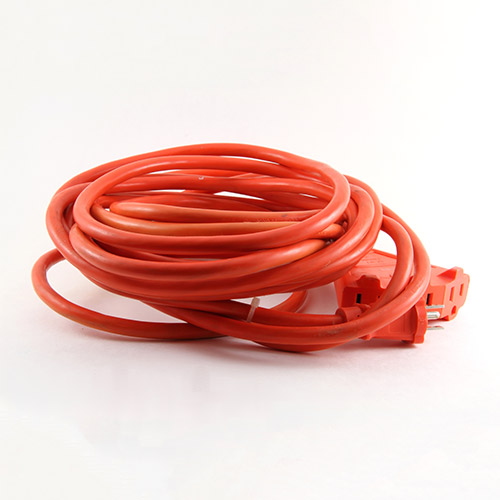Basics of Connecting to Your Home
Extension Cords
- Less Expensive
- No installation needed
- Best for powering basics, like fridge, lights, and charging phones
- Cannot be used to power appliances that are hardwired (furnace, hot water heater, etc.)
- Best for short term, occasional power outages and smaller generators
Extension cords are the easiest and least expensive option. But, they do have limitations on what they can power. If you only have occasional need for backup power, and you only want to power the basics, using extension cords is a good option.
To connect your generator, you’ll run extension cords from the appliances you want to power to the generator. You’ll want to make sure the generator is a safe distance from your home, and of course, keep all doors and windows closed.
You can use extension cords to power your refrigerator, coffee maker, microwave, chargers for electronic devices, and much more.
However, you cannot power items like ceiling fans, overhead lights, or your furnace or hot water heater with extension cords. These items are wired into your home, so they don’t have a separate plug to connect to the extension cord.

Transfer Switches
- Easier and more convenient than extension cords
- Powers more appliances, like your furnace, well pump, and water heater
- Easy to manage power from different areas of your house
- Needs to be installed by an electrician
A transfer switch is an electrical device that switches the power from your electrical utility to your generator, and vice versa. It is usually installed next to the electric panel in your home. An inlet box is usually installed to your home’s exterior to connect the generator.
A transfer switch makes it easy and convenient to power your home. When the power goes out, you simply flip the switch to “Generator Power,” connect your generator, and start the generator. There’s no need to mess with multiple extension cords.
A transfer switch lets you use your home's wiring system to power any appliance in your home with your generator quickly and easily. This includes items like a furnace or a well pump, ceiling fans, and other appliances are hard wired into your home. A transfer switch is the easiest and safest way to connect these items to the generator.
A transfer switch can also increase the usefulness of your generator. A transfer switch makes power management very easy to do. You can easily turn on and off various circuits to accommodate changing power needs.
This helps you to use a smaller, less expensive generator to meet your power needs. It lets you use your generator more efficiently - with less effort on your part.
Our Universal Transfer Switch, for example, can increase the usefulness of your generator, making it behave like a model as much as 20% larger.
A licensed electrician is recommended to install your transfer switch. Your local Honda dealer can often recommend a good electrician to help you with this. Learn more about how a transfer switch works and how it will be installed.
There are many different kinds of transfer switches available. Your Honda dealer will help you to choose one that works best with your power needs. Or, you can use our basic recommendations here.

Never Plug a Generator Directly into an Outlet
You might hear someone suggest you just “plug the generator into an outlet” to power your home. This is not a safe idea and should never be done..
If you plug your generator into your home without a transfer switch, the power from your generator will back-feed – meaning it goes back down the utility lines. Back-feeding could electrocute any technicians who are working on the lines - causing injury or even death.
In addition, if your generator is powering your home, and the utility power comes back on, it could not only damage the generator, but has the potential to cause a fire in your home.
A transfer switch eliminates the risk of back-feeding. It is the only safe way to connect your generator directly to your home. This is why a transfer switch is required by the National Electric Code for any connection of power to a home.










